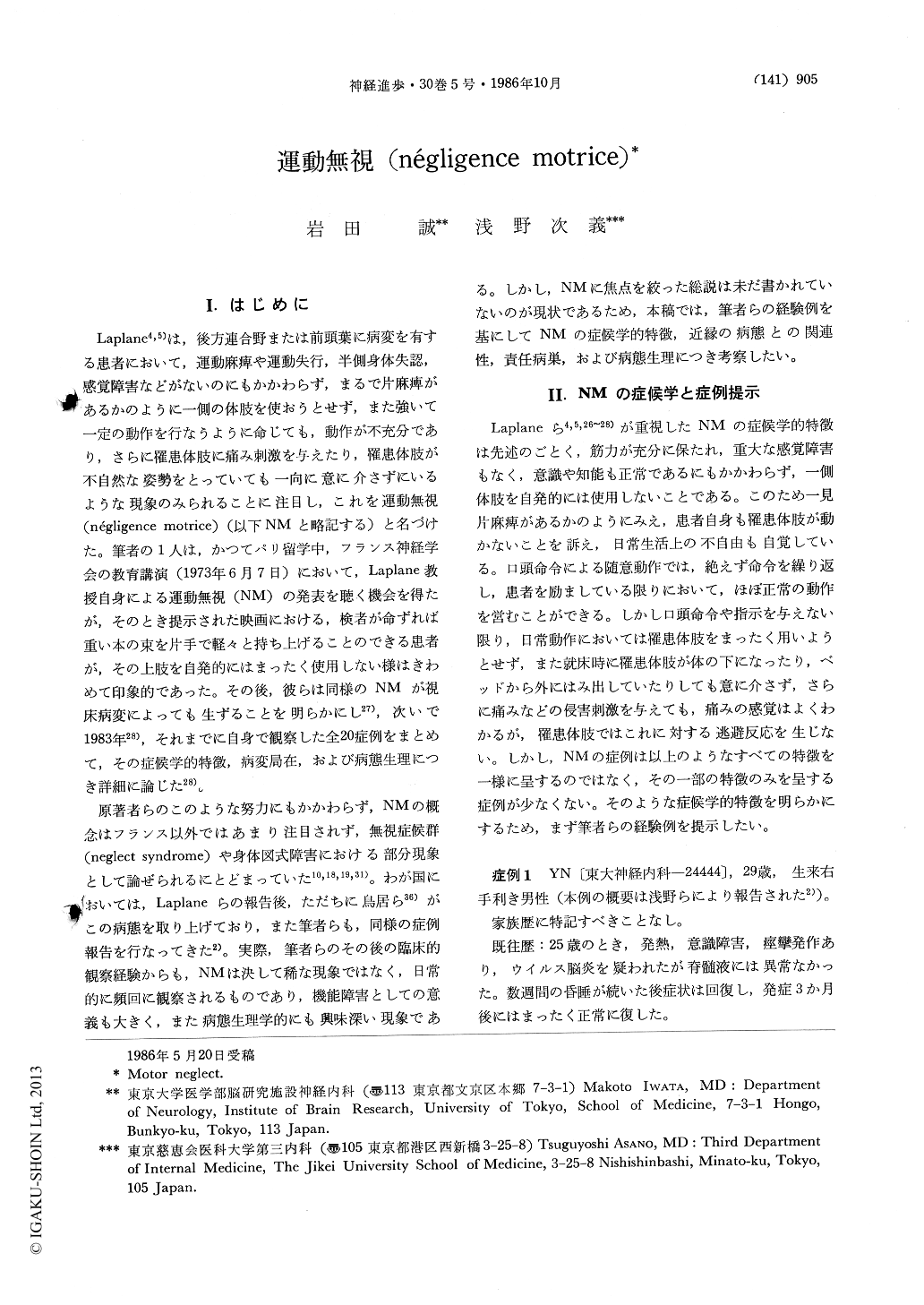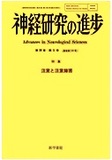Japanese
English
- 有料閲覧
- Abstract 文献概要
- 1ページ目 Look Inside
I.はじめに
Laplane4,5)は,後方連合野または前頭葉に病変を有する患者において,運動麻痺や運動失行,半側身体失認,感覚障害などがないのにもかかわらず,まるで片麻痺があるかのように一側の体肢を使おうとせず,また強いて一定の動作を行なうように命じても,動作が不充分であり,さらに罹患体肢に痛み刺激を与えたり,罹患体肢が不自然な姿勢をとっていても一向に意に介さずにいるような現象のみられることに注目し,これを運動無視(négligence motrice)(以下NMと略記する)と名づけた。筆者の1人は,かつてパリ留学中,フランス神経学会の教育講演(1973年6月7日)において,Laplane教授自身による運動無視(NM)の発表を聴く機会を得たが,そのとき提示された映画における,検者が命ずれば重い本の束を片手で軽々と持ち上げることのできる患者が,その上肢を自発的にはまったく使用しない様はきわめて印象的であった。その後,彼らは同様のNMが視床病変によっても生ずることを明らかにし27),次いで1983年28),それまでに自身で観察した全20症例をまとめて,その症候学的特徴,病変局在,および病態生理につき詳細に論じた28)。
原著者らのこのような努力にもかかわらず,NMの概念はフランス以外ではあまり注目されず,無視症候群(neglect syndrome)や身体図式障害における部分現象として論ぜられるにとどまっていた10,18,19,31)。わが国においては,Laplaneらの報告後,ただちに鳥居ら36)がこの病態を取り上げており,また筆者らも,同様の症例報告を行なってきた2)。実際,筆者らのその後の臨床的観察経験からも,NMは決して稀な現象ではなく,日常的に頻回に観察されるものであり,機能障害としての意義も大きく,また病態生理学的にも興味深い現象である。しかし,NMに焦点を絞った総説は未だ書かれていないのが現状であるため,本稿では,筆者らの経験例を基にしてNMの症候学的特徴,近縁の病態との関連性,責任病巣,および病態生理につき考察したい。
Motor neglect, isolated by Laplane in 1970 as a specific neurological syndrome consists of several seemingly independent functional disturbance units such as the disuse of the affected extremities and the lack of the active correcting reaction to the undesirable situations of them. The first components of the motor neglect, the lack of spontaneity on one side of the extremities, is further classified into three different conditions : the disuse of the unilateral extremities in daily life activity, especially in dressing or in manipulation of the objects, the disuse of one hand in bilateral simultaneous hand movements, and the lack of the spontaneous gesture in free conversation. According to this semiological analysis, the present authors reported three cases of motor neglect presenting diflerent clinical pictures. The first patient affected with acute disseminated encephalomyelitis showed marked disuse of the right upper extremity in daily life activity in spite of the absence of the significant involvement of muscular power and the sensation. He also showed mild indifference to the situations of the right upper extremity, but he could clearly recognize his right upper extremity as his own and noted the motor disturbance of it. Although the CT scan could not reveal the site of lesion in this patient, the association of the aphasia of conduction type and the mild right hemispatial neglect implies that the main lesion was in the left parietal lobe. The second patient with an infarct affecting the right premotor area showed a limb kinetic apraxia of the left hand. In daily life activity, he showed only mild disuse of the left upper extremity, and bilateral simultaneous movements of the hands were well performed. However, the free conversation revealed a marked reduction of the free gesture of the left upper extremity. He had neither hemiasomatognosia nor anosognosia at all. The third patient showed left hemisensory deficit without weakness due to the right parietal infarct involving the postcentral and the supramarginal gyri. In spite of the complete absence of any pyramidal sign, the patient showed marked dropping of the left extremity on Barre's and Mingazzini's tests. As her left extremity did not drop when she was asked to maintain the postures of the abovementioned tests raising only the left side, the dropping of the left extremities of the patient at the time of the bilateral simultaneous raising was considered to be due to a kind of sensory extinction that interrupts the deep sensory feedback control of the isometric voluntary muscular contraction necessary for maintaining a fixed posture without visual control. In addition to this, she also showed a slight disuse of the left hand in daily life activity. But the spontaneous gestures in free conversation did not reveal any laterality. The patient was fully aware of her functional deficit of the left hand and could easily recognize the left extremities as her own. Anatomical studies of the hitherto reported motor neglect patients revealed that it could result from either cerebral cortical or thalamic lesion. As to the cortical lesions, the responsible hemisphere could be either the right or the left, and the site of the lesion is one of the following regions : supplementary motor area, premotor area or posterior inferior parietal area. Although Valenstein et al. insisted the caudate head as the lesion site causing motor neglect, the review of their CT scan pictures could confirm that the lesion of their case was really affecting the thalamus. Consequently, no evidence of the human materials revealing the striatum as the site of lesion of motor neglect seems so far to be available. Of interest is the fact that all the cases of motor neglect of the thalamic origine are due to the right-sided lesion, and not a single case of the left thalamic lesion causing motor neglect has ever been reported.

Copyright © 1986, Igaku-Shoin Ltd. All rights reserved.


